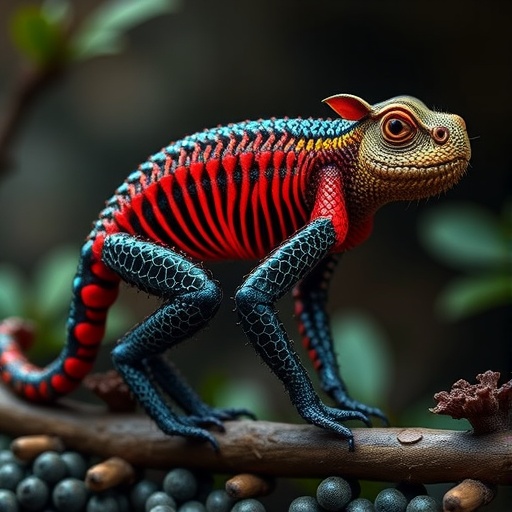In a groundbreaking new study published in the prestigious journal Proceedings of the National Academy of Sciences, researchers from University College London and the University of Reading have unveiled intriguing insights into the evolutionary dynamics of cancer across species. This pioneering investigation sheds light on how rapid evolutionary changes in certain animals influence the prevalence and nature of tumors, fundamentally challenging longstanding notions in cancer biology.
Cancer, commonly perceived solely as a medical affliction arising from cellular malfunction, is increasingly recognized as an ecological and evolutionary phenomenon. By examining tumor prevalence across a diverse range of species, scientists are beginning to decode how evolutionary pressures sculpt cancer resistance mechanisms. The recent study focuses specifically on the contrast between malignant (cancerous) and benign (non-cancerous) tumors, revealing that these two categories of growths may be subject to very different evolutionary forces.
Prior research has demonstrated a paradox in cancer rates: larger animals possess more cells and thus theoretically greater cancer risks, yet some large species, such as elephants, appear to possess enhanced cancer suppression strategies. Building on this foundation, the current examination focused on species undergoing rapid changes in body size over evolutionary timescales, including iconic examples like the Greater Kudu and Big Horn Sheep, to ascertain whether the pace of body size evolution correlates with tumor dynamics.
Remarkably, the investigators discovered that species exhibiting rapid evolutionary increases in body size tend to have significantly fewer malignant tumors. This suggests that evolution has, in some lineages, honed more robust anti-cancer defenses as these species adapted to new physiological demands inherent in larger body sizes. Conversely, benign tumors did not demonstrate the same decline, implying they have not been the target of similar natural selective pressures.
Professor Chris Venditti, senior author on the study, emphasizes the implications of these findings, stating that cancer is not merely a cellular pathology but a mirror reflecting the evolutionary histories and ecological contexts of organisms. He underscores that exploring the emergence and persistence of tumors across species is vital for understanding the underlying biological mechanisms of cancer and may reveal novel avenues for therapeutic innovation.
The research team expanded their analysis across mammals and birds, encompassing data from 87 mammalian species and 77 avian species, unearthing fascinating differences between these vertebrate classes. While mammals displayed decreased malignant tumor rates in species with accelerated body size evolution, a contrasting pattern emerged in birds. Avian lineages that speciated more quickly had an increased prevalence of both benign and malignant tumors.
This discrepancy between mammals and birds is posited to originate from genomic architecture differences. Birds possess smaller, more compact genomes relative to mammals, potentially constraining their capacity to mitigate deleterious mutations and chromosomal rearrangements that can promote oncogenesis. Dr. George Butler, lead author of the paper, highlights that birds’ compact genomes might increase susceptibility to genetic ‘mix-ups’—such as gene fusions—commonly implicated in more aggressive cancers, exemplified by analogous fusion events in human prostate cancer.
These insights demonstrate an evolutionary trade-off: while rapid speciation and body size changes may enhance cancer defenses in some taxa, genomic constraints can hinder such adaptations in others. The study positions evolutionary rate as a critical factor modulating cancer resistance and tumor biology, a concept that may transform conventional understandings rooted in size and lifespan correlations.
Furthermore, the selective pressure seems to act distinctly on malignant tumors, the aggressive and invasive forms of cancer, rather than benign growths, which do not typically threaten organismal survival. This selective divergence suggests evolutionary mechanisms specifically target pathways contributing to cancer malignancy, opening new investigative pathways into cancer’s evolutionary underpinnings.
Importantly, these revelations are not solely of academic interest—they hold profound implications for human cancer research. The identification of evolved cancer resistance strategies in rapidly changing species could inspire novel approaches to treatment, particularly addressing the challenge of treatment-resistant cancers. By contextualizing human tumors within a broader evolutionary framework, medicine may adopt more sophisticated strategies that harness lessons from nature’s own evolutionary experiments.
The concept that the pace and mode of evolution influence cancer susceptibility reframes cancer as more than a disease of cellular errors; it is an adaptive battle waged across millions of years. The evolutionary arms race between tumor development and host defenses reflects a complex interaction shaped by environmental pressures, genetic architecture, and species-specific life histories.
In conclusion, this landmark study not only enhances our understanding of cancer biology across the animal kingdom but also ushers in a paradigm shift by marrying cancer research with evolutionary science. As we unravel the evolutionary fingerprints etched into tumor dynamics, we pave the way for breakthroughs that may one day translate into innovative cancer therapies for humans, informed by the natural history of life itself.
Subject of Research: Evolutionary dynamics of tumor prevalence in rapidly evolving species
Article Title: Divergent evolutionary dynamics of benign and malignant tumors
News Publication Date: 7-Nov-2025
Web References: DOI: 10.1073/pnas.2519203122
Keywords: Evolutionary genetics, cancer resistance, tumor evolution, malignant tumors, benign tumors, comparative oncology, body size evolution, phylogenetics, genome compactness
Tags: cancer biology and evolutioncancer resistance mechanismscancer suppression strategies in large animalscomparative oncology in wildlifeecological perspectives on cancerevolutionary dynamics of cancerevolutionary pressures on tumor developmentgroundbreaking cancer research findingsmalignant vs benign tumorsrapid evolutionary changes in speciesspecies-specific cancer ratestumor prevalence in animals





